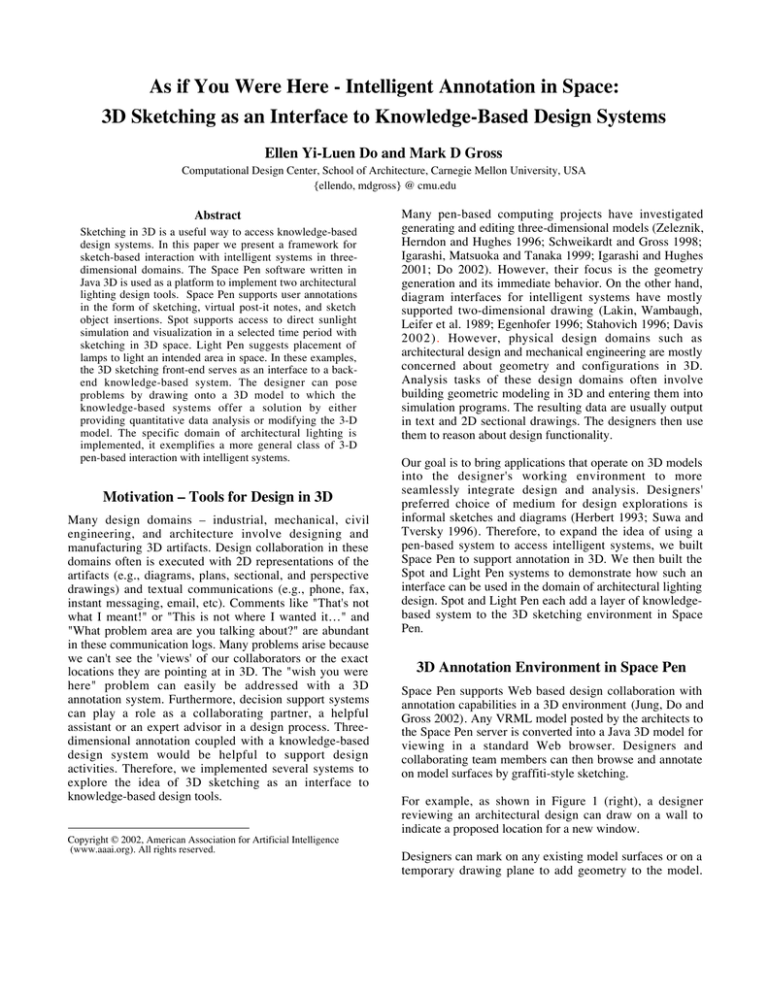
As if You Were Here - Intelligent Annotation in Space:
3D Sketching as an Interface to Knowledge-Based Design Systems
Ellen Yi-Luen Do and Mark D Gross
Computational Design Center, School of Architecture, Carnegie Mellon University, USA
{ellendo, mdgross} @ cmu.edu
Abstract
Sketching in 3D is a useful way to access knowledge-based
design systems. In this paper we present a framework for
sketch-based interaction with intelligent systems in threedimensional domains. The Space Pen software written in
Java 3D is used as a platform to implement two architectural
lighting design tools. Space Pen supports user annotations
in the form of sketching, virtual post-it notes, and sketch
object insertions. Spot supports access to direct sunlight
simulation and visualization in a selected time period with
sketching in 3D space. Light Pen suggests placement of
lamps to light an intended area in space. In these examples,
the 3D sketching front-end serves as an interface to a backend knowledge-based system. The designer can pose
problems by drawing onto a 3D model to which the
knowledge-based systems offer a solution by either
providing quantitative data analysis or modifying the 3-D
model. The specific domain of architectural lighting is
implemented, it exemplifies a more general class of 3-D
pen-based interaction with intelligent systems.
Motivation – Tools for Design in 3D
Many design domains – industrial, mechanical, civil
engineering, and architecture involve designing and
manufacturing 3D artifacts. Design collaboration in these
domains often is executed with 2D representations of the
artifacts (e.g., diagrams, plans, sectional, and perspective
drawings) and textual communications (e.g., phone, fax,
instant messaging, email, etc). Comments like "That's not
what I meant!" or "This is not where I wanted it…" and
"What problem area are you talking about?" are abundant
in these communication logs. Many problems arise because
we can't see the 'views' of our collaborators or the exact
locations they are pointing at in 3D. The "wish you were
here" problem can easily be addressed with a 3D
annotation system. Furthermore, decision support systems
can play a role as a collaborating partner, a helpful
assistant or an expert advisor in a design process. Threedimensional annotation coupled with a knowledge-based
design system would be helpful to support design
activities. Therefore, we implemented several systems to
explore the idea of 3D sketching as an interface to
knowledge-based design tools.
Copyright © 2002, American Association for Artificial Intelligence
(www.aaai.org). All rights reserved.
Many pen-based computing projects have investigated
generating and editing three-dimensional models (Zeleznik,
Herndon and Hughes 1996; Schweikardt and Gross 1998;
Igarashi, Matsuoka and Tanaka 1999; Igarashi and Hughes
2001; Do 2002). However, their focus is the geometry
generation and its immediate behavior. On the other hand,
diagram interfaces for intelligent systems have mostly
supported two-dimensional drawing (Lakin, Wambaugh,
Leifer et al. 1989; Egenhofer 1996; Stahovich 1996; Davis
2002). However, physical design domains such as
architectural design and mechanical engineering are mostly
concerned about geometry and configurations in 3D.
Analysis tasks of these design domains often involve
building geometric modeling in 3D and entering them into
simulation programs. The resulting data are usually output
in text and 2D sectional drawings. The designers then use
them to reason about design functionality.
Our goal is to bring applications that operate on 3D models
into the designer's working environment to more
seamlessly integrate design and analysis. Designers'
preferred choice of medium for design explorations is
informal sketches and diagrams (Herbert 1993; Suwa and
Tversky 1996). Therefore, to expand the idea of using a
pen-based system to access intelligent systems, we built
Space Pen to support annotation in 3D. We then built the
Spot and Light Pen systems to demonstrate how such an
interface can be used in the domain of architectural lighting
design. Spot and Light Pen each add a layer of knowledgebased system to the 3D sketching environment in Space
Pen.
3D Annotation Environment in Space Pen
Space Pen supports Web based design collaboration with
annotation capabilities in a 3D environment (Jung, Do and
Gross 2002). Any VRML model posted by the architects to
the Space Pen server is converted into a Java 3D model for
viewing in a standard Web browser. Designers and
collaborating team members can then browse and annotate
on model surfaces by graffiti-style sketching.
For example, as shown in Figure 1 (right), a designer
reviewing an architectural design can draw on a wall to
indicate a proposed location for a new window.
Designers can mark on any existing model surfaces or on a
temporary drawing plane to add geometry to the model.
Figure 1 (left) shows a new wall piece extension sketched
on the temporary wall. Simple stroke recognition in Space
Pen identifies figures such as arrows, rectangles, and
circles. Once recognized, these sketch objects can be
rectified as model geometry or interpreted as commands.
In short, Space Pen provides a platform for drawing onto
and into 3D models.
Space Pen also supports text annotation with Post-It® style
tags that can be attached and will remain in the model. The
3D-located threaded discussions are linked to issues and
authors. When a new annotation note is made the Space
Pen server automatically sends emails to inform all related
stakeholders about the feedback.
Figure 1. Sketch annotation in Space Pen on temporary
surface (left) or existing surface in the model (right).
Sunlight Visualization in Spot
The Spot system supports lighting visualization through
sketching. Designer can sketch a boundary shape on the 3D
model to indicate the area intended for simulation. Spot
then generates a representation of the spatial distribution of
the illumination level on a selected surface over time. Spot
also enables designers to visualize the temporal
information of light distribution over time for a given
point. For each point the user taps on the 3D model, Spot
generates a calendar diagram of a chart where the X and Y
axis represent the months of the year and the time of the
day. The color of each calendar cell is the result of the
calculation of the light amount reaching this specific point.
of 3D geometry are implemented for easy navigation with
standard interface (mouse, arrow keys or joystick) and text
annotation and sketching (pen and tablet). The temporal
variables (date and time) are displayed in additional views
with the appearance of a graphic calendar. The resulting
sunlight simulation (in gradient distribution) is displayed
on the 3D environment. Spot also supports collaboration
over the web. Simple modifications on the model’s
geometry can be made with freehand sketching input for
daylight simulation.
Lighting Fixture Advisor in Light Pen
The Light Pen system connects a 3D sketching front end
to a rule-based electrical lighting fixture advisor. The
designer interacts directly with the 3D Space Pen
environment that supports browsing and sketching. After
importing a three-dimensional (VRML) model the designer
marks up the model to indicate desired area for lighting
effects. The model geometry and the designer’s lighting
sketch marks are passed to the Lux lighting design advisor.
Lux is Light Pen’s ‘back end’ intelligent system, coded as
a set of lighting design decision rules. Lux accepts the
lighting sketch marks and building geometry as inputs.
Based on the desired lighting and the model geometry Lux
infers the contexts, recommends solutions, and then selects
fixtures from a catalog based on their desired
characteristics. Finally it passes these recommendations
back to Space Pen, which adds the fixtures to the 3D model
to indicate Lux’s proposed design solution.
Figure 3. Light Pen recognizes the intended sketch for lit
area and places lamps appropriated for the lighting effect.
Discussion
Figure 2. A boundary area sketch (left) on the wall
activates sunlight distribution simulation (right).
The Spot system consists of the 3D sketching front end to a
rule-based sunlight simulation. Two complementary
components are implemented in Spot: 1) Time Projection
and 2) Navigable Animation. The spatial variables (x, y, z)
Sketching on a 3D model to identify desired lighting
effects sparked the development of the Light Pen and Spot.
More generally, we saw that sketching in 3-D could be a
direct and natural means to interact with systems that
reason about and calculate on three-dimensional models.
References
Davis, R: 2002, Sketch Understanding in Design: Overview of
Work at the MIT AI Lab, AAAI Spring Symposium, 24-31.
Do, EY-L: 2002, Drawing Marks, Acts and Reacts: toward a
computational sketching for architectural design, AIEDAM I
Parmee & I Smith, Cambridge University Press, 16: 149-171.
Egenhofer, M: 1996, Spatial-Query-by-Sketch, IEEE Symposium
on Visual Languages, 60-67.
Igarashi, T and JF Hughes: 2001, A Suggestive Interface for 3D
Drawing, UIST, ACM: 173-181.
Igarashi, T, S Matsuoka and H Tanaka: 1999, Teddy: a sketching
interface for 3D freeform design, Proceedings of the SIGGRAPH
1999 annual conference on Computer graphics, 409-416.
Jung, T, EY-L Do and MD Gross: 2002, From Redliner to Space
Pen, ACM Intelligent User Interfaces, 95-102.
Lakin, F, J Wambaugh, L Leifer, D Cannon and C Steward: 1989,
The electronic notebook: performing medium and processing
medium, Visual Computer, 5 214-226.
Schweikardt, E and MD Gross: 1998, Digital Clay: Deriving
Digital Models from Freehand Sketches, ACADIA 98. T.
Seebohm and S. V. Wyk, Quebec City, Canada: 202-211.
Stahovich, TF: 1996, SketchIT: a Sketch Interpretation Tool for
Conceptual Mechanical Design, PhD, Artificial Intelligence
Laboratory, Massachusetts Institute of Technology,
Zeleznik, RC, KP Herndon and JF Hughes: 1996, Sketch: An
Interface for Sketching 3D Scenes, SIGGRAPH '96, 163-170.




